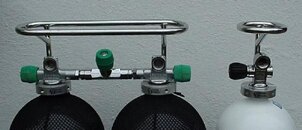… Does anyone care to offer their theory as to why valve(s) are positioned behind the diver's head?
Not a theory, it is the cheapest. Valve-up is “good enough” for the vast majority of a very small customer base. That customer base is spending leisure money compared to fire fighters that need to get a job done under difficult conditions.
The minute percentage of divers that use doubles, let alone in demanding conditions, is such a small market that manufacturing and marketing costs dictate prices that are well above what the vast majority are willing to pay. All that leaves is home-brew solutions made by individuals for personal use… sort of like the first backplates for cave divers.
I have valve protectors mounted, similar to the ones used for under-ice diving. Any other theories ?
I’m not familiar with these, got pictures?
Last edited:





